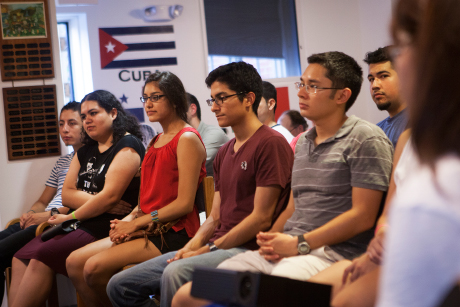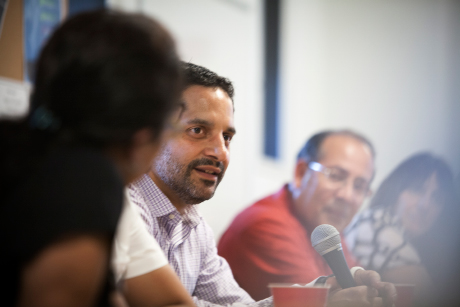Panel reflects on Latino experience at Cornell
By Daniel Aloi



Cornell’s incoming Latino student population has grown in recent years, from 10.1 percent of the Class of 2014 to 12.7 percent of the Class of 2018. While they have had an official home on campus for 20 years, students, faculty and administrators in the Latino community say progress can still be made.
More than 50 people gathered Sept. 5 for “Latinos at Cornell,” a panel discussion at the Latino Living Center (LLC) in Anna Comstock Hall.
The program included a historic overview, from La Asociación Latina (LAL) being founded in 1975 to the November 1993 student occupation of Day Hall, precipitated by an act of vandalism to Daniel Martinez’ artwork on the Arts Quad. The LLC opened the following fall.
Law School Dean Eduardo Peñalver ’94 was involved in the “spontaneous” occupation that Friday, 21 years ago. “Our group was about half black and half Latino,” he said. “We went to Day Hall and sought a meeting with President Frank Rhodes, but he was out of town … the group decided to sit in until a meeting was promised.”
Rhodes’ administration “really did give us a lot of what we were asking for,” Penalver said. “It was the beginning of a change that I think has persisted.”
“What are some prevalent issues that you have seen affecting Latinos in the past few years?” LAL co-chair Sarah Proo ’15 asked the panel.
“Latinos may be 12 percent of our students, but our Latino faculty is still about 3.3 percent,” said Latino Studies Program Director Sofia Villenas, adding that students still encounter “micro-aggressions.”
“We are still being marginalized in much more subtle ways,” said Vilma Santiago-Irizarry, professor of anthropology. “We still have a long way to go.”
Peñalver cited the recent welcome barbecue for Latino students. “When I was a freshman in Arts and Sciences, we didn’t have this place [the LLC], or these numbers, or an event like that,” he said. “The progress we’ve made is remarkable, but there is room to improve. Recruiting more Latino faculty should be a top priority.”
Asked to compare their experiences at Cornell with those at other institutions, Assistant Dean of Students Andrew Martínez ’12 said he “was surprised at the difference” when he went to the University of Pennsylvania for graduate school. “I found the Latino community at Cornell to be very tight, but at Penn [we] didn’t get the support student organizations get here.”
Peñalver said he went from a 7 percent Latino population at Cornell to Yale Law School where, “in a class of 200, there were six or seven of us.”
Roberto López ’15 asked the panel how students could contribute to the university. Peñalver suggested joining Cornell’s Farmworker Program: “You’re empowered here, but you’re also empowered as citizens. … There are Latinos all around us in upstate New York – they’re not visible, they’re isolated, and they need your support.”
Undergraduate admissions multicultural coordinator Angela Herrera ’03 promoted Diversity Hosting Month. “This is one of the most diverse classes ever,” she said. “There’s a very active academic and socially supportive community here. The families [of prospective students] that visit here will then go visit Howard and Rice and other colleges, and they’ll see that [we] really care and are a very active community.”
“How many here are the first generation to go to college?” asked Hector Vélez, Ph.D. ’83, an adjunct associate professor of sociology. About a third of those present raised their hands. “In 20 years, no one will raise their hands to that question because they will be your children coming here.”
Get Cornell news delivered right to your inbox.
Subscribe